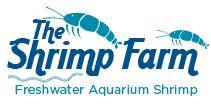Blue bee shrimp (Paracaridina sp. "Blue bee") care & info
Looking for a stripey shrimp but don't want to go for regular ol' crystal reds? You'll love Paracaridina sp. "Blue bee", also known as the blue bee shrimp. This uncommon species is a real looker and not too difficult to keep.
Keep reading for everything you need to know about Paracaridina sp. and keeping this fascinating dwarf shrimp in your own aquarium!
| Scientific name | Paracaridina sp. "Blue Bee" |
| Common name | Blue bee shrimp |
| Difficulty level | Easy |
| Origin | China |
Paracaridina sp. "Blue bee" naming & appearance
When one says "bee shrimp", most shrimp keepers' minds immediately go to Caridina cantonensis, which are sometimes referred to as bee shrimp as well. All the more confusing that these blue bees are actually a different species! Blue bees are members of the genus Paracaridina, although it appears unclear which specific species they are. Interbreeding with Caridina cantonensis species has been reported, though.
This is a relatively small dwarf shrimp with a maximum size of around 0.8 inches. The species is brownish to blueish in color with narrow vertical white stripes.
Setting up a Paracaridina sp. “Blue Bee” aquarium
Blue bee shrimp requirements are pretty similar to those of crystal red & black shrimp. You'll need an aquarium of 5 gallons or more; if you're a beginner, it's a good idea to go a little larger than the bare minimum. It'll be easier to keep things stable that way.
Your aquarium should always be filtered and fully cycled (more about water quality can be found below). Try a sponge filter or something with a filter guard, as you won't want to lose any fry from this uncommon shrimp variety. You'll also need a heater if ambient temperatures aren't stable, since (dwarf) shrimp don't respond well to sudden temperature swings.
Like all shrimp species, blue bee shrimp are prey animals that will do best when provided with plenty of hiding places. Hides don't have to be fancy or complicated: some live plants, shrimp tubes and other decor should be enough to keep your blue bees stress-free and happy.
Water quality
Good water quality is the key to healthy (blue bee) shrimp! Most importantly, never introduce any livestock if your aquarium is not fully cycled yet. No idea what that means? Thoroughly read this article before heading out and getting your shrimp.
Keep a close eye on your water values using a liquid test kit (drop tests are known to be inaccurate), making sure ammonia and nitrite are always at 0. Nitrates should ideally be <10 and can be kept low by doing regular water changes and adding live plants.
pH: 6.0-7
Temperature: 68-77 °F
Tankmates
Stick with the safest options for this tiny dwarf shrimp by keeping your tank invert-only or choosing only the most peaceful fish tankmates. All fish that get the chance to fit a shrimp in their mouth will gladly do so, which means microfish like dwarf Corydoras are your best bet if you don't want to lose any fry.
To answer the question many might be asking: yes, there are reports of Paracaridina and Caridina shrimp interbreeding. Although they are from different genera, they are very similar and the current taxonomy might be inaccurate. So be warned, if you don't want your blue bees to cross with your Caridina shrimp, don't keep them in the same tank (you could consider Neocaridina species instead). If you do want to experiment, most sources discuss cross-breeding with Caridina cantonensis, which might work.
Paracaridina sp. "Blue bee" diet
Like most dwarf shrimp, blue bee shrimp are omnivorous detritus feeders with a preference for plant material. This means that in the aquarium, they'll spend a large portion of their day foraging for leftovers, dead plant matter and algae/biofilm.
You can supplement their diet in all sorts of ways. Leave algae to grow in a few places, feed a high-quality shrimp food on a daily basis, offer fresh blanched veggies once in a while and toss some leaf litter or cholla wood in your tank as a semi-permanent source of shrimp snacks.
Breeding Paracaridina sp. "Blue bee"
Breeding Paracaridina sp. "Blue bee" should be similar to breeding Caridina cantonensis. These shrimp breed in freshwater and are pretty prolific. They don't need any interference on your part as long as you keep them happy, healthy and well-fed.
Buying Paracaridina sp. "Blue bee"
Blue bee shrimp are a relatively new and uncommon addition to the shrimp hobby, so don't expect to come across them at your average aquarium store. If you want to keep these shrimp, you'll likely have to search for a seller online. Fellow hobbyists might be able to help you out and there are also various online stores out there that sell (imported) blue bee shrimp.




 Shrimp
Shrimp Fish
Fish Crab &
Crab & Plants
Plants Foods
Foods Snails
Snails